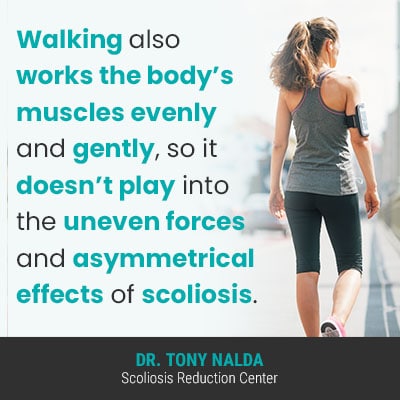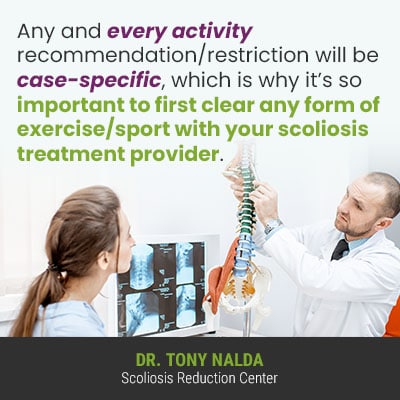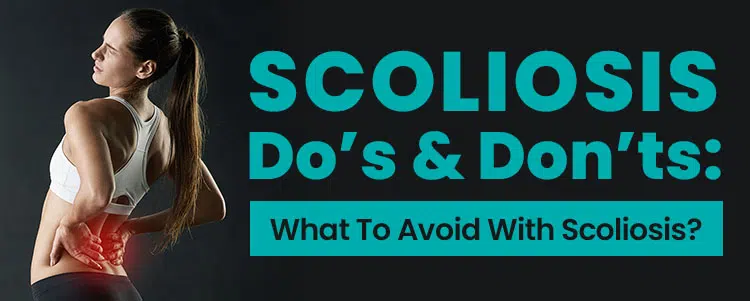Scoliosis is a highly-variable condition, meaning its characteristics differ greatly from one patient to another. Not only are there different types with varying underlying causes, but the condition also ranges from mild to moderate and severe to very severe; therefore, the do’s & don’ts of life with scoliosis will be case-specific.
Scoliosis do’s & don’ts and what to avoid with scoliosis will be case-specific. In general, do’s include staying active while approaching certain activities with caution, and don’ts include sports/exercises that negatively impact the spine, interfere with treatment, or risk spinal injury.
Before addressing some of the common questions regarding safe and unsafe activities for people with scoliosis, let’s touch on some of the defining condition characteristics that shape a person’s experience of life with the condition.
What it Means to Have Scoliosis
If a person is diagnosed with scoliosis, it means their spine has an unnatural sideways curve, with rotation, and is of a minimum size. Not only does the scoliotic spine bend unnaturally to the side, but it also twists from front to back, back to front, making it a 3-dimensional condition.
No two cases of scoliosis are the same, and this is because scoliosis varies greatly in terms of how it affects patients of different ages, types and causation, curvature location, and condition severity.
Condition severity is determined by a measurement known as Cobb Angle, and the higher the Cobb angle, the larger the unnatural curve, and the more severe a condition is classified as:
- Mild scoliosis: Cobb angle measurement between 10 and 25 degrees
- Moderate scoliosis: Cobb angle measurement of between 25 and 40 degrees
- Severe scoliosis: Cobb angle measurement of 40+ degrees
- Very-severe scoliosis: Cobb angle measurement of 80+ degrees
When it comes to scoliosis type and causation, the most prevalent form of scoliosis is adolescent idiopathic scoliosis (AIS), diagnosed between the ages of 10 and 18, and idiopathic means not clearly associated with any single-known cause.
Idiopathic scoliosis accounts for 80 percent of known diagnosed scoliosis cases, and the remaining 20 percent have known causes and are classified as: neuromuscular, congenital, degenerative, or traumatic scoliosis.
In addition, scoliosis can develop anywhere along the spine: cervical (neck), thoracic (middle/upper back), and lumbar (lower back), and different curvature locations/patterns produce different effects.
Scoliosis also affects adults and adolescents differently, particularly in terms of pain, and this is due to growth and maturity; scoliosis becomes a compressive condition in adulthood once skeletal maturity has been reached.
In children and adolescents who are still growing, the lengthening motion of a growing spine counteracts the compressive force of the curvature, keeping the condition from being noticeably painful.
So, you can see that based on patient age, causation/type, curvature location, and condition severity, each case will be different. This is why there is no general one-size-fits-all answer to the topic of safe or unsafe activities for people with scoliosis. What might be deemed appropriate and safe for one patient might not be for another, and vice versa.
Now that we understand the variables that determine how a person will experience their condition and dictate what’s safe and unsafe for them to do, let’s address some additional scoliosis topics.
What to Avoid When you Have Scoliosis
When it comes to what to avoid when you have scoliosis, in terms of activities, exercises, and sports, any activity that strains the spine, puts it at risk of injury, or in an unnatural position should be avoided, or at the very least, approached with caution.
Collision sports like football and hockey are not recommended for people with scoliosis because they can lead to spinal injury, and repeated shocks and jarring motions increase compression of the spine and its surroundings, which adults living with scoliosis are already prone to.
Sports and exercises that involve hyperextending the spine or unnaturally arching the spine, like gymnastics and diving, should also be avoided or approached with caution by people with scoliosis because a scoliotic spine has already lost its healthy curves, and this exposes the spine to more adverse tension.
Sports and activities that overuse one side of the body, like golf and tennis, are generally not recommended for people with scoliosis because as the condition introduces uneven forces to the body, muscle imbalance can become a problem, and related sore, stiff, and strained muscles can become painful, not to mention compromising their ability to optimally support/stabilize the spine.
When a muscle is overactive on one side of the body, it can pull on the opposite side with the weak muscle and increase postural deviation, which is the main visual symptom of scoliosis.
So, what about two of the most common forms of exercise: walking and running?
Is Walking Good for Scoliosis?
Walking is one of the best forms of exercise for a variety of people, including those living with scoliosis. The very design of the spine is based on movement, so while back pain is often responded to with less movement, low-impact exercise is the best way to keep the spine, and its surrounding muscles, as loose and flexible as possible.
A healthy spine is made up of rectangular-shaped vertebrae stacked on top of one another in a straight and neutral alignment, and adjacent vertebrae are separated by intervertebral discs.
The discs are essential spinal structures in terms of function and overall health, and they are also commonly the first spinal structures to show signs of deterioration and feel the effects of inactivity.
The discs don’t have their own vascular supply and lose fluid as we age, so they are replenished through movement, and increased circulation in their surroundings.
Walking is a healthy and safe form of low-impact exercise that can help increase circulation around the spine so the discs can absorb important nutrients and maintain their fluid levels to prevent disc desiccation.

Walking also works the body’s muscles symmetrically, so it doesn’t play into the uneven forces and asymmetrical effects of scoliosis.
So now that we know walking is good for people with scoliosis, what about running?
Running with Scoliosis
While running with scoliosis can be safe for some, long-distance running is not commonly recommended as a scoliosis-friendly activity because every time the foot hits the ground, spinal compression occurs, and not as gently as it does when walking.
Running over hills or other uneven terrains will increase the compression factor, not to mention making the back bend and rotate unnaturally.
While short sprints are considered safer than long distance for those with scoliosis, this is because prolonged running/jogging exposes the spine to compressive forces for longer and can become a factor in scoliosis progression.
So is running bad for scoliosis: it can be, particularly with long-distance running as it increases spinal compression and the risk of progression.
As a progressive condition, scoliosis has it in its very nature to worsen over time, especially if left untreated or not treated proactively.
What Makes Scoliosis Worse?
If an activity or sport exposes the spine to uneven forces, increases spinal compression, adverse spinal tension, or puts it at risk of injury, these things can make scoliosis worse, but the best way to prevent scoliosis from getting worse is by seeking out proactive treatment as close to the time of diagnosis as possible.
An important part of effective scoliosis treatment involves managing the condition’s progressive nature, and while we don’t always know what causes scoliosis to develop in idiopathic cases, we do know what the condition’s main trigger for progression is: growth and development.
Children and adolescents are at a higher risk of rapid-phase progression because of the amount of growth and development they have yet to go through, while adults tend to progress more slowly because the big growth trigger has been removed.
It is, however, still important to understand that although adults tend to progress slower, they will still progress over time, particularly when age-related spinal degeneration comes into play, and the cumulative effect of incremental progression can still add up to a large scoliotic-curve size increase over time.
The most detrimental thing for a person with scoliosis to do is to ignore it; proactive treatment offered here at the Scoliosis Reduction Center® can help patients work towards a curvature reduction and increasing core strength so the spine is optimally supported and stabilized.
Through condition-specific chiropractic care, in-office therapy, custom-prescribed home exercises, and corrective bracing, scoliosis progression can be managed effectively, but only if proactive treatment efforts are made to counteract the condition’s natural tendency to worsen over time.
Now that we know what makes scoliosis worsen, let’s return to some activity-related topics.
Swimming with Scoliosis
When it comes to swimming with scoliosis, there are different ways to address this topic, as well as different views. In general, swimming is a positive form of exercise for people with scoliosis because the weightless environment removes compression and pressure on the spinal joints, but competitive swimming can be a different matter.
Swimming is also good because it works the body’s muscles symmetrically; however, it’s thought that competitive swimming is not the best because it involves spending more than 6 hours in the pool a day, and eliminating feedback by the unnatural body positioning during swimming, for such extended periods of time, can negatively affect scoliosis.
When most people perform the breaststroke, for example, their nose is in the water, facing the bottom of the pool, and this involves unnaturally flattening or arching the thoracic spine, and for some, this can increase condition progression.
For those with scoliosis interested in strength training, weight lifting is another activity that should be approached with caution.
Weight Lifting with Scoliosis
When it comes to working out with scoliosis and lifting weights, people have to be cautious as hoisting heavyweights over the head can increase spinal compression, strain an already-strained spine, and increase the risk of spinal injury.
However, if free weight lifting is performed under the guidance of a professional and given the go-ahead by your scoliosis treatment provider, gentle weight lifting can help increase core strength, which means the muscles that surround the spine can help support and stabilize it, and this can be helpful for people with scoliosis.

Any and every activity recommendation/restriction will be case-specific, which is why it’s so important to first clear any form of exercise/sport with your scoliosis treatment provider.
Part of my treatment, here at the Center, involves lifestyle guidance, and this includes comprehensively assessing each and every condition to find that ideal balance of safe activities and forms of exercise that can augment treatment, and not put the spine under any further strain.
Something many people living with scoliosis find to be a challenge is sitting/standing for long periods of time, and this is related to weakened muscles and energy expenditure.
Best Sitting Position for Scoliosis
For someone with scoliosis, sitting or standing for long periods of time can become increasingly uncomfortable, especially once the condition becomes compressive in adulthood.
The lumbar spine supports the weight of the trunk, and when a person is sitting, the increased pressure on the spine can cause pain and discomfort, particularly when sitting for long periods of time.
When it comes to finding the best sitting position for scoliosis, this would be in a reclined position, so the weight of the trunk is distributed throughout the spine and not concentrated in the lower back.
Sitting in a reclined position also removes the pressure point of the lower body contacting the seat as the pressure point is spread throughout the spine where it contacts the back of the chair.
Reclining also counteracts gravity and compression, so the best sitting position for people with scoliosis is in a reclined position, and taking frequent breaks from sitting can also be helpful as movement makes the spine and surrounding muscles more loose and flexible.
As scoliosis develops and progresses, it shifts the body’s natural center of gravity, causing changes to gait, balance, and coordination, so a person with scoliosis is going to expend more energy in an effort to stay upright and maintain good posture, while trying to counteract the uneven and unnatural pull of the spine.
Now that we have covered the biggest do’s & don’ts for people with scoliosis, let’s talk about treatment as this is the only way to impact the condition on a structural level while managing progression effectively.
Proactive Scoliosis Treatment: The Most Important Do of Scoliosis
We’ve spent a lot of time discussing the types of activities/sports/exercises that should be avoided by people with scoliosis, so let’s switch gears and address the most important thing a person can do once diagnosed with scoliosis: seek out proactive treatment.
When a person is diagnosed with scoliosis, the most important decision is how to treat it effectively, and it’s important to understand that different treatment approaches offer patients different potential outcomes.
When I say proactive treatment, I’m not talking about the traditional approach to scoliosis treatment because it’s more reactive than proactive.
Traditional Scoliosis Treatment versus Conservative Treatment
Traditional treatment values watching and waiting, in mild cases, to monitor for progression, but as we know all cases of scoliosis are virtually guaranteed to progress at one point or another, I see this as wasting valuable treatment time; conservative treatment responds very differently to a scoliosis diagnosis.
Remember, as a progressive condition, where a person’s scoliosis is at the time of diagnosis is not indicative of where it will stay; the only way to prevent progression and increasing condition severity is to work towards impacting the condition on a structural level with proactive treatment.
Here at the Center, I see cases of mild scoliosis as an opportunity to keep them that way and avoid increasing severity, escalating symptoms, and the need for more invasive forms of treatment in the future.
On the traditional path of scoliosis treatment, patients only receive treatment in the moderate stage of progression, and this is in the form of traditional bracing, which is known to have a number of shortfalls, and if bracing is ineffective at preventing further progression and patients cross into the severe and very-severe classification, they are commonly funneled into spinal fusion surgery.
Just like all surgeries, spinal fusion comes with its share of risks and complications, not to mention how living with a fused spine changes the do’s & don’ts of life with scoliosis.
A fused spine is often more rigid, has a decreased range of motion, and is more prone to injury, so activity restrictions can be more strict, and the psychological impact of living with a fused spine prevents many individuals from trying new things and/or participating in the sports/activities they once loved.
Conservative Treatment and Scoliosis-Specific Exercises
While treatment results can never be guaranteed, here at the Center, I value a conservative chiropractic-centered treatment approach that integrates multiple forms of treatment for the most specific and successful results.
I combine condition-specific chiropractic care, in-office therapy, custom-prescribed home exercises, and corrective bracing to impact the condition on all levels: structurally and in terms of increasing core strength for optimal muscle support.
When it comes to the do’s & don’ts of scoliosis, an important distinction I’d like to make clear is the difference between general physical therapy exercises and scoliosis-specific exercises (SSEs).
While general exercise and physical therapy doesn’t have the potential to impact scoliosis in terms of correction, this is because it’s too general and not scoliosis-specific, but when SSEs are integrated into a proactive treatment plan and performed as prescribed by a scoliosis specialist, they can be a valuable part of achieving successful treatment results.
Scoliosis-specific exercises can help strengthen the spine and its surrounding muscles, and help keep the spine and its surrounding muscles as loose and flexible as possible: making the spine more responsive to treatment.
SSEs can also activate certain areas of the brain for enhanced brain-body communication, and this can result in postural remodeling and a healthier and sustainable body position.
Conclusion
I’ve worked hard to rewrite the narrative surrounding scoliosis; this is because many people are unaware of the different treatment options available and assume that a scoliosis diagnosis means leading a life of limitations.
Not only can most people still fulfill their dreams and life goals with scoliosis, but they can also thrive with it.
As such a prevalent and complex condition that’s been around since ancient times, our understanding of the condition, and how it responds to treatment has evolved over the years, and patients no longer have only one treatment approach available to them.
When it comes to scoliosis do’s & don’ts and knowing what to avoid with scoliosis, the answer will be case-specific and determined by important patient/condition variables such as patient age and overall health, condition type (causation), curvature location, and condition severity.
Activity recommendations and restrictions won’t be consistent across the board, which is why any and all forms of exercise/sports should first be cleared by a patient’s scoliosis treatment provider to ensure they are appropriate for the individual patient and won’t interfere with treatment.
In general, scoliosis don’ts would include activities that increase compression, adverse spinal tension, place the spine in unnatural positions, exacerbate muscle imbalance, and increase the risk of spinal injury; scoliosis do’s would include staying active, increasing core strength so there’s less pressure on the spine to maintain its natural curves and alignment, and most importantly, treating it proactively.
Here at the Scoliosis Reduction Center®, the right time to start treating scoliosis, regardless of age, is always now, as staying ahead of the curve is key to treatment success and improved quality of life.





